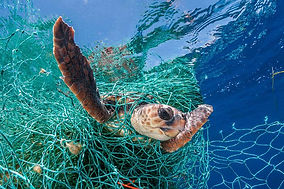

THE PROBLEM: OCEAN GARBAGE PATCHES
the example of the Great Pacific Garbage Patch
The Great Pacific Garbage Patch is one of the largest continents of floating garbage polluting the oceans and seas. Located in the North of the Pacific Ocean, this territory expands to 1.6 million km² which is the equivalent of three times the size of France. The presence of this plastic waste is harmful to wildlife and humans, and blocks phytoplankton from absorbing CO2.

© GNOSIS NETWORK
1.6 million km²
80 000 tons of garbage

x3
FRANCE
.png)

x2
TEXAS

The Great Pacific Garbage Patch is mostly composed of plastic waste and fishing nets brought in by currents and tides.

Marine Life Affected
Human Life Affected
Climate change

-
Plastic debris causes the deaths of more than 1 million seabirds every year, as well as more than 100,000 marine mammals.
(Unesco, Facts and figures on marine
pollution, 2017)

-
70 % of deep sea fish have eaten plastic.
-
55 % of fish species we eat are found with microplastics in their gastrointestinal tract.
(Study by NUI Galway on microplastics
ingested by deep water fish in the
Northwest Atlantic Ocean)

-
1/3 of the global CO2 emission caused by human activity is absorbed by the ocean.
-
During their photosynthesis phytoplankton absorb the carbon.
-
Phytoplankton has thus an important role in the fight against climate change.
-
The plastic waste present on the ocean blocks the phytoplankton from completing this CO2 absorption.
(Nasa, Earth Observatory,
The importance of phytoplankton)
The 5 ocean gyres
Garbage patches have formed all around the world. Today, we can count five of them.

